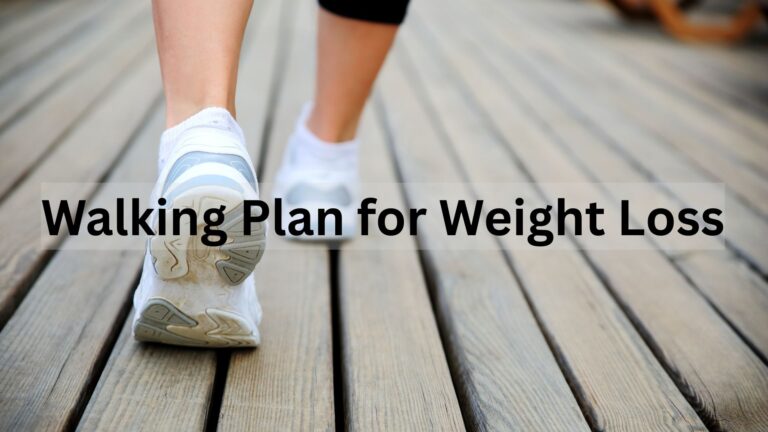Walking is one of the simplest yet most effective ways to lose weight, boost metabolism, and improve overall health. Unlike high-intensity workouts that may feel intimidating, walking is accessible, low-impact, and sustainable, making it ideal for beginners and seasoned fitness enthusiasts alike. When paired with consistency, proper technique, and structured progression, a walking plan for weight loss can produce impressive results over time.
In this comprehensive guide, we’ll cover the science behind walking for weight loss, a detailed step-by-step walking plan, tips to maximize fat burning, and strategies to stay motivated.
Why Walking is Effective for Weight Loss
Walking may seem simple, but it has numerous physiological benefits that make it an effective weight-loss tool:
- Burns calories: Depending on intensity, pace, and body weight, walking can burn between 150–400 calories per hour.
- Boosts metabolism: Regular walking increases energy expenditure and supports fat oxidation.
- Supports lean muscle mass: Walking engages the glutes, quadriceps, hamstrings, and core, preserving muscle while losing fat.
- Reduces stress: Walking lowers cortisol levels, which can help prevent stress-related weight gain.
- Improves cardiovascular health: Walking strengthens the heart, lungs, and circulation, which enhances overall fitness.
Key Insight: Unlike fad diets or extreme workouts, walking is sustainable long-term, making it easier to maintain weight loss results.

How to Walk for Maximum Fat Burn
Not all walking sessions are equal. To optimize fat burning and weight loss, consider these strategies:
1. Walk at the Right Intensity
- Moderate intensity: A brisk pace where talking is possible but singing is difficult.
- Target heart rate: 50–70% of your maximum heart rate.
- Benefits: Increases calorie burn while being gentle on joints.
2. Include Interval Walking
- Alternate between fast-paced walking for 1–2 minutes and slower recovery walking for 1–2 minutes.
- Benefits: Boosts calorie burn, improves cardiovascular fitness, and accelerates fat loss.
3. Use Inclines and Hills
- Walking uphill or on an incline treadmill activates more muscles, especially glutes and hamstrings.
- Tip: Start with a 2–5% incline and gradually increase as your fitness improves.
4. Add Light Weights
- Use ankle weights, wrist weights, or a weighted vest to increase resistance.
- Benefits: Enhances muscle engagement and calorie expenditure.
5. Focus on Posture
- Keep shoulders back, core engaged, and head up.
- Swing arms naturally to increase intensity and balance.

The Ultimate Walking Plan for Weight Loss
This step-by-step walking plan is designed for beginner, intermediate, and advanced walkers, progressively increasing intensity to maximize results.
Week 1–2: Build Consistency
- Frequency: 5 days per week
- Duration: 20–30 minutes per session
- Pace: Brisk but comfortable
- Focus: Establish habit, maintain good posture, and track steps
Week 3–4: Increase Duration
- Frequency: 5–6 days per week
- Duration: 30–45 minutes
- Pace: Brisk, moderate intensity
- Additions: Begin light interval walking (1 min fast / 2 min slow)
Week 5–6: Introduce Intervals and Inclines
- Frequency: 6 days per week
- Duration: 40–50 minutes
- Structure:
- 5 minutes warm-up
- 20 minutes brisk walking with 1–2 minute intervals of faster pace
- 10–15 minutes walking uphill or on incline
- 5 minutes warm-up
- Goal: Enhance calorie burn and cardiovascular fitness
Week 7–8: Advanced Walking
- Frequency: 6–7 days per week
- Duration: 45–60 minutes
- Structure:
- 5 minutes warm-up
- 30 minutes brisk walking with intervals and incline
- 10 minutes cool-down and stretching
- 5 minutes warm-up
- Optional: Add light hand weights or resistance bands for full-body engagement
Tip: Track progress using a pedometer or fitness app to monitor distance, pace, and calories burned.

Tips to Maximize Walking for Weight Loss
1. Walk After Meals
- Walking after eating helps stabilize blood sugar and supports digestion.
- A 10–15 minute walk post-lunch or dinner can enhance fat-burning.
2. Hydrate Properly
- Drink water before, during, and after walking to maintain performance and metabolism.
- Proper hydration prevents fatigue and aids calorie burning.
3. Wear Proper Footwear
- Invest in supportive walking shoes to prevent injury and improve comfort.
4. Incorporate Mindful Walking
- Focus on breathing, stride, and posture to increase mental clarity and reduce stress, which can impact weight management.
5. Pair with a Balanced Diet
- Walking alone is effective, but combining it with a calorie-conscious diet rich in protein, fiber, and healthy fats accelerates fat loss.
Tracking Your Progress
Measuring progress is crucial to staying motivated and achieving long-term success:
- Step Count: Aim for 10,000 steps daily, gradually increasing.
- Distance: Track miles or kilometers walked per week.
- Body Measurements: Monitor waist, hips, and weight weekly.
- Fitness Metrics: Note energy levels, endurance, and walking pace improvements.
Pro Tip: Celebrate small victories to stay consistent and maintain motivation.

Benefits Beyond Weight Loss
While the primary goal may be fat loss, walking offers numerous additional health benefits:
- Improved heart health: Reduces blood pressure, cholesterol, and risk of cardiovascular disease.
- Better mental health: Boosts mood, reduces anxiety, and improves cognitive function.
- Enhanced joint health: Low-impact walking strengthens knees and hips without excessive strain.
- Boosted metabolism: Regular movement helps regulate insulin sensitivity and blood sugar levels.
- Increased stamina: Gradual progression improves endurance, making daily activities easier.
Walking is a holistic exercise that supports both physical and mental well-being, making it an ideal weight-loss strategy.
Common Mistakes to Avoid
- Walking too slowly: To burn calories effectively, maintain a brisk pace.
- Skipping intervals or incline: Neglecting intensity reduces fat-burning potential.
- Ignoring posture: Slouching can cause back pain and reduce exercise effectiveness.
- Overtraining: Rest days are essential for recovery and preventing fatigue.
- Neglecting nutrition: Walking without mindful eating can slow down weight loss results.
Conclusion: Start Your Walking Journey Today
Walking is a powerful, accessible, and sustainable strategy for weight loss. By following a structured walking plan, incorporating intervals, incline, and proper nutrition, you can burn fat, boost metabolism, and improve overall health. Remember, consistency is key—small daily efforts compound into remarkable long-term results.
Start today: lace up your walking shoes, set a goal, and embrace this simple yet effective approach to weight loss and a healthier lifestyle.


